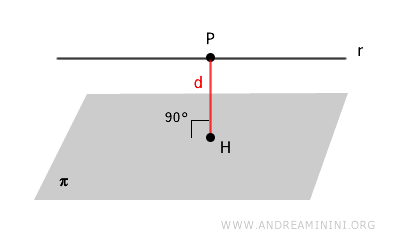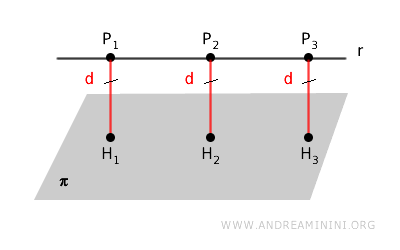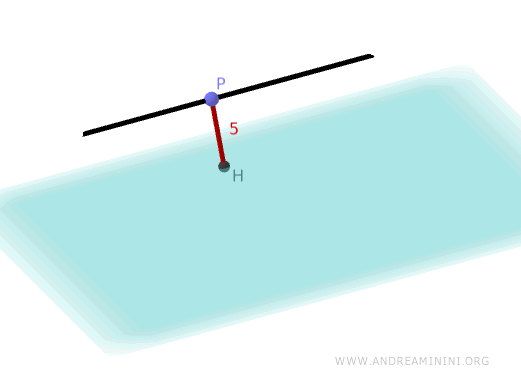Distance Between a Line and a Parallel Plane
The distance \( d \) between a line \( r \) and a parallel plane \( \pi \) is calculated by selecting a point \( P \) on the line and projecting it perpendicularly onto the plane.

The formula to compute the distance \( d \) from a point \( P(x_0, y_0, z_0) \) to a plane defined by the equation \( ax + by + cz + d = 0 \) is:
$$ d = \frac{|ax_0 + by_0 + cz_0 + d|}{\sqrt{a^2 + b^2 + c^2}} $$
This formula gives the length of the perpendicular segment connecting \( P \) to the plane \( \pi \). Since the line \( r \) is parallel to the plane, this distance is the same for any point on the line.

Example
Let’s consider the plane \( \pi \) described by the equation:
$$ 2x - 3y + 6z + 9 = 0 $$
Suppose the line \( r \) is defined by the parametric equations:
$$ x = 13 + 3t $$
$$ y = 2t $$
$$ z = 0 $$
To confirm that the line \( r \) is parallel to the plane \( \pi \), we calculate the dot product of the plane’s normal vector \( (2, -3, 6) \) and the line’s direction vector \( (3, 2, 0) \):
$$ 2 \cdot 3 + (-3) \cdot 2 + 6 \cdot 0 = 6 - 6 + 0 = 0 $$
Since the dot product is zero, the line is indeed parallel to the plane.
Next, we select a point on the line \( r \). For \( t = 0 \), the point is \( (13, 0, 0) \). Using the distance formula, we calculate:
$$ d = \frac{|2(13) - 3(0) + 6(0) + 9|}{\sqrt{2^2 + (-3)^2 + 6^2}} $$
$$ d = \frac{|26 + 9|}{\sqrt{4 + 9 + 36}} $$
$$ d = \frac{35}{\sqrt{49}} $$
$$ d = \frac{35}{7} = 5 $$
Therefore, the distance between the line \( r \) and the plane \( \pi \) is 5.

And so on.
